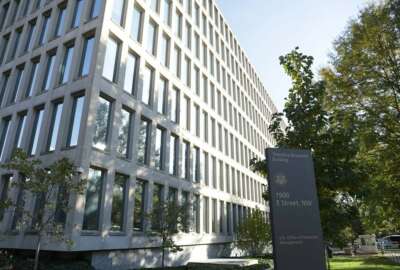Do clothes make the person, or vice versa?
Dress codes, already blurring for years, have really gotten hard to decipher post pandemic.
“Dress like a bureaucrat, think like a bureaucrat.”
That’s the advice a Department of Veterans Affairs employee, now with Health and Human Services, received from his boss upon joining federal service 15 years ago. Having taken it to heart, he told me he wears bright colors on the job to this day.
The sartorial habits of the federal workforce probably never made it into Vogue, but as FedFashionWeek concludes today, we know that lots of federal employees do indeed think and care about what they wear. Dressing for work has become more complicated in recent years with the advent of the great vagary: business casual. The telework-on-Zoom phenomenon has only made it harder.
At one time, dressing for work made for relatively easy choices. Dresses or skirt-and-blouse for women, suit and tie for men. There was a time when, at IBM, if a man showed up for work in suit, repp tie and blue — not white — shirt, a manager might remark, only half-kiddingly, “Vacation day?” Today virtually no workplace demands full business dress of men or women on days in the office or teleworking, or not meeting with clients, members of Congress, or visiting commanding generals.
Many of the people featured in FedFashionWeek have it easy, in the sense that specific, often outdoor work requires specific garb. They exhibit “the role functional fashion plays in carrying out their essential, mission-oriented work.” Like the hard-hatted, life-jacketed National Oceanic and Atmospheric Administration worker tending to a buoy. Or the FDA Office of Regulatory Affairs investigators in dark blue outfits resembling police uniforms, complete with black shoes and FDA-embroidered ball caps.
One inspector general told me that his office’s investigators would bristle at having to dress like, say, members of the president’s Secret Service detail. The IG agents regularly join up with law enforcement to, say, execute a search warrant of dangerous premises. So they typically wear tactical gear. But think of how bad it would look in reverse, if the president were surrounded by guards in black tactical gear.
But then, there’s the lady who answers phones at the Agriculture Department’s meat and poultry hotline. She could probably wear anything, since her work entails answering phone calls and emails. But she is well turned out in a black dress. The gallery includes a group of Rocky Mountain region General Services Administration employees organizing food basket donations. They exhibit open collared shirts, shirt and tie, dresses, and skirt-and-pullover combos. They all look like “work” and not like “party.”
Dress codes vary according to a particular office’s culture, the work actually done there, distance from headquarters, prevailing climate, and host of other factors. Certain offices, like Buckingham Palace or the White House, project a pretty clear mandate, even for weekend work.
Otherwise, there’s surprisingly little guidance on this. But the Office of Personnel Management does not house any governmentwide dress code. It’s up to each agency. On an obscure page in the OPM website, I found this tidbit on a list of telework tips: “If participating in a meeting via webcam, be presentable. Remember, getting dressed for work will help you get in a mindset for work.”
You won’t find much consensus even on that assertion. Productivity and a mindset for work don’t necessarily correlate with attire for many people. For federal employees, the question is, what feels comfortable in the cultural gestalt of your agency, and what might be most suitable, no pun intended, for encounters with the public, or with vendors.
In government, the top leadership, as in the president, the code is suit and tie, period. Ralph Lauren did President Joe Biden’s suit for Inauguration Day. Prince, now King, Charles, has closets full of Anderson & Sheppard bespoke suits (they start at about $6,000 each). Except when he wears a kilt.
Federal News Network’s Jory Heckman recently reported on a March 22 agreement between the National Federation of Federal Employees and the the New Orleans passport center for a decidedly casual bent. But the agreement also requires employees to sharpen up if, say, a congressional delegation stops by.
In the corporate world, anything goes. Recall that the legendary Steve Jobs never wore anything but jeans and a turtleneck. The Facebook fellow seems to mostly appear in T-shirts, but he found a suit when testifying to Congress. In its 2021 annual report, Chairman Arvind Krishna appears in a natty cross-hatch jacked and open-neck shirt — unthinkable a generation ago. GM Chair Mary Barra is pictured in what appears to be a jacket for driving — you can see a line of zipper and a snap closure at the neck. Harley-Davidson Chairman Jochen Zeitz appears in, what else, a leather-and-logo’d motorcycle jacket. By contract, Transportation Secretary Pete Buttigieg, in his picture, conforms to the government standard — dark suit, blue tie, national and departmental flags forming the backdrop.
Context is everything. And that’s part of the difficulty in the casual age.
Federal employees who meet the public fall into two basic categories. One is uniformed, like Border Patrol or TSA officers, National Park Service rangers, or officers of any of the dozens of agency police forces. Uniformed jobs are a settled dress question.
Then there’s everyone else, from secretary to clerk, whose encounters should should convey qualities such as competence, non-partiality, or what you might call professionalism.
Personal note: I always look at shoes. Polished shoes make up for a lot of wardrobe sins north of the feet.
Nearly Useless Factoid
The average person sheds 1.5 grams of skin flakes every day
Source: American Lung Association
Copyright © 2025 Federal News Network. All rights reserved. This website is not intended for users located within the European Economic Area.
Tom Temin is host of the Federal Drive and has been providing insight on federal technology and management issues for more than 30 years.
Follow @tteminWFED




